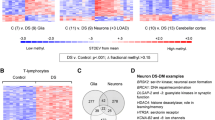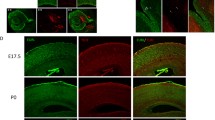Summary.
Down syndrome (DS) is the most frequent genetic disorder with mental retardation and caused by trisomy 21. Although the molecular mechanisms of the various phenotypes of DS could be due to overexpression of gene(s) on chromosome 21, several groups have challenged this gene dosage effect hypothesis. The near completion of the sequencing of human chromosome 21 provides unprecedented opportunities to understand the molecular pathology of DS, however, functional information on gene products is limited so far. We therefore evaluated the levels of six proteins whose genes are encoded on chromosome 21 (trefoil factor 1, trefoil factor 2, trefoil factor 3, coxsackie virus and adenovirus receptor, carbonyl reductase 1 and interferon-α receptor) in fetal cerebral cortex from DS and controls at the early second trimester using Western blot analysis. None of the investigated proteins showed overexpression in DS compared to controls suggesting that these proteins are not involved in abnormal development of fetal DS brain and that DS phenotype can not be simply explained by the gene dosage effect hypothesis. We are systematically quantifying all proteins whose genes are encoded on chromosome 21 and these studies may provide a better understanding of genotype-phenotype correlation in DS.
Similar content being viewed by others
Refereance
Abramovich C, Ratovitski E, Lundgren E, Revel M (1994) Identification of mRNAs encoding two different soluble forms of the human interferon alpha-receptor. FEBS Lett 338: 295–300
Balcz B, Kirchner L, Cairns N, Fountoulakis M, Lubec G (2001) Increased brain protein levels of carbonyl reductase and alcohol dehydrogenase in Down syndrome and Alzheimer’s disease. J Neural Transm [Suppl 61]: 193–201
Bergelson JM, Cunningham JA, Droguett G, Kurt-Jones EA, Krithivas A, Hong JS, Horwitz MS, Crowell RL, Finberg RW (1997) Isolation of a common receptor for Coxsackie B viruses and adenoviruses 2 and 5. Science 275: 1320–1323
Bergelson JM, Krithivas A, Celi L, Droguett G, Horwitz MS, Wickham T, Crowell RL, Finberg RW (1998) The murine CAR homolog is a receptor for coxsackie B viruses and adenoviruses. J Virol 72: 415–419
Bernal RM, Sharma S, Gardner BK, Douglas JT, Bergelson JM, Dubinett SM, Batra RK (2002) Soluble coxsackievirus adenovirus receptor is a putative inhibitor of adenoviral gene transfer in the tumor milieu. Clin Cancer Res 8: 1915–1923
Bork P (1993) A trefoil domain in the major rabbit zona pellucida protein. Protein Sci 2: 669–670
Busciglio J, Yankner BA (1995) Apoptosis and increased generation of reactive oxygen species in Down’s syndrome neurons in vitro. Nature 378: 776–779
Chen YH, Lu Y, De Plaen IG, Wang LY, Tan XD (2000) Transcription factor NF-kB signals antianoikic function of trefoil factor 3 in intestinal epithelial cells. Biochem Biophys Res Commun 274: 576–582
Cheon MS, Bajo M, Kim SH, Claudio JO, Stewart AK, Patterson D, Kruger WD, Kondoh H, Lubec G (2003a) Protein levels of genes encoded on chromosome 21 in fetal Down syndrome brain: challenging the gene dosage effect hypothesis (Part II). Amino Acids 24: 119–125
Cheon MS, Kim SH, Ovod V, Kopitar Jerala N, Morgan JI, Hatefi Y, Ijuin T, Takenawa T, Lubec G (2003b) Protein levels of genes encoded on chromosome 21 in fetal Down syndrome brain: challenging the gene dosage effect hypothesis (Part III). Amino Acids 24: 127–134
Cohen CJ, Shieh JT, Pickles RJ, Okegawa T, Hsieh JT, Bergelson JM (2001) The coxsackievirus and adenovirus receptor is a transmembrane component of the tight junction. Proc Natl Acad Sci USA 98: 15191–15196
Colamonici O, Yan H, Domanski P, Handa R, Smalley D, Mullersman J, Witte M, Krishnan K, Krolewski J (1994) Direct binding to and tyrosine phosphorylation of the alpha subunit of the type I interferon receptor by p135tyk2 tyrosine kinase. Mol Cell Biol 14: 8133–8142
Cutrone EC, Langer JA (1997) Contributions of cloned type I interferon receptor subunits to differential ligand binding. FEBS Lett 404: 197–202
Engidawork E, Balic N, Fountoulakis M, Dierssen M, Greber-Platzer S, Lubec G (2001) -Amyloid precursor protein, ETS-2 and collagen alpha 1 (VI) chain precursor, encoded on chromosome 21, are not overexpressed in fetal Down syndrome: further evidence against gene dosage effect. J Neural Transm [Suppl 61]: 335–346
Fechner H, Haack A, Wang H, Wang X, Eizema K, Pauschinger M, Schoemaker R, Veghel R, Houtsmuller A, Schultheiss HP, Lamers J, Poller W (1999) Expression of coxsackie adenovirus receptor and alpha-integrin does not correlate with adenovector targeting in vivo indicating anatomical vector barriers. Gene Ther 6: 1520–1535
Gauzzi MC, Barbieri G, Richter MF, Uze G, Ling L, Fellous M, Pellegrini S (1997) The amino-terminal region of Tyk2 sustains the level of interferon alpha receptor 1, a component of the interferon alpha/beta receptor. Proc Natl Acad Sci USA 94: 11839–11844
Goldman LA, Zafari M, Cutrone EC, Dang A, Brickelmeier M, Runkel L, Benjamin CD, Ling LE, Langer JA (1999) Characterization of antihuman IFNAR-1 monoclonal antibodies: epitope localization and functional analysis. J Interferon Cytokine Res 19: 15–26
Greber-Platzer S, Schatzmann-Turhani D, Cairns N, Balcz B, Lubec G (1999) Expression of the transcription factor ETS2 in brain of patients with Down syndrome-evidence against the overexpression-gene dosage hypothesis. J Neural Transm [Suppl 57]: 269–281
Gulesserian T, Engidawork E, Fountoulakis M, Lubec G (2001) Antioxidant proteins in fetal brain: superoxide dismutase-1 (SOD-1) protein is not overexpressed in fetal Down syndrome. J Neural Transm [Suppl 61]: 71–84
Gulesserian T, Kim SH, Fountoulakis M, Lubec G (2002) Aberrant expression of centractin and capping proteins, integral constituents of the dynactin complex, in fetal Down syndrome brain. Biochem Biophys Res Commun 291: 62–67 Hitora M, Awatsuji H, Sugihara Y, Miyashita S, Furukawa Y, Hayashi K (1995) Expression of pS2 gene in rat brain. Biochem Mol Biol Int 5: 1079–1084
Hoffmann W, Jagla W (2002) Cell type specific expression of secretory TFF peptides: Colocalization with mucin and synthesis in the brain. Int Rev Cyto 213: 147–181
Hoffmann W, Jagla W, Wiede A (2001) Molecular medicine of TFFpeptides: from gut to brain. Histol Histopathol 16: 319–334
Honda T, Saitoh H, Masuko M, Katagiri-Abe T, Tominaga K, Kozakai I, Kobayashi K, Kumanishi T, Watanabe YG, Odani S, Kuwano R (2000) The coxsackievirus-adenovirus receptor protein as a cell adhesion molecule in the developing mouse brain. Brain Res Mol Brain Res 77: 19–28
Ishikura S, Yamamto Y, Matsuura K, Wei J, Hodes ME, Hara A (1998) Properties and tissue distribution of mouse monomeric carbonyl reductase. Biol Pharm Bull 21: 879–881
Jagla W, Wiede A, Dietzmann K, Rutkowski K, Hoffmann W (2000) Colocalization of TFF3 peptide and oxytocin in the human hypothalamus. FASEB J 14: 1126–1131 Kinoshita T, Taupin DR, Itoh H, Podolsky DK (2000) Distinct pathways of cell migration and antiapoptotic response to epithelial injury: Structure- function analysis of human intestinal trefoil factor. Mol Cell Biol 20: 4680–4690
Lalani EN, Willams R, Jayaram Y, Gilbert C, Chaudhary KS, Sku LS, Koumarianou A, Playford R, Stamp GWH (1999) Trefoil factor-2, human spasmolytic polypeptide, promotes branching morphogenesis in MCF-7 cells. Lab Invest 79: 537–546
Lemieux N, Malfoy B, Forrest GL (1993) Human carbonyl reductase (CBR) localized to band 21q22.1 by high-resolution fluorescence in situ hybridization displays gene dosage effects in trisomy 21 cells. Genomics 15: 169–172
Ling LE, Zafari M, Reardon D, Brickelmeier M, Goelz SE, Benjamin CD (1995) Human type I interferon receptor, IFNAR, is a heavily glycosylated 120–130 kD membrane protein. J Interferon Cytokine Res 15: 55–61
Marks A, O’Hanlon D, Lei M, Percy ME, Becker LE (1996) Accumulation of S100 beta mRNA and protein in cerebellum during infancy in Down syndrome and control subjects. Brain Res Mol Brain Res 36: 343–348
May FEB, Semple JI, Newton JL, Westley B (2000) The human two domain trefoil protein, TFF2, is glycosylated in vivo in the stomach. Gut 46: 454–459
Novick D, Cohen B, Rubinstein M (1992) Soluble interferon-alpha receptor molecules are present in body fluids. FEBS Lett 314: 445–448
Odetti P, Angelini G, Dapino D, Zaccheo D, Garibaldi S, Dagna-Bricarelli F, Piombo G, Perry G, Smith M, Traverso N, Tabaton M (1998) Early glycoxidation damage in brains from Down’s syndrome. Biochem Biophys Res Commun 243: 849–851
Pestka S, Langer JA, Zoon KC, Samuel CE (1987) Interferons and their actions. Annu Rev Biochem 56: 727–777
Probst JC, Skutella T, Mueller-Schmid A, Jirikowski GF, Hoffmann W (1995) Molecular and cellular analysis of rP1.B in the rat hypothalamus: In situ hybridization and immunohistochemistry of a new P-domain neuropeptide. Mol Brain Res 33: 269–276
Taub JW, Huang X, Matherly LH, Stout ML, Buck SA, Massey GV, Becton DL, Chang MN, Weinstein HJ, Ravindranath Y (1999) Expression of chromosome 21-localized genes in acute myeloid leukemia: differences between Down syndrome and non-Down syndrome blast cells and relationship to in vitro sensitivity to cytosine arabinoside and daunorubicin. Blood 94: 1393–1400
Taupin DR, Kinoshita K, Podolsky DK (2000) Intestinal trefoil factor confers colonic epithelial resistance to apoptosis. Proc Natl Acad Sci USA 97: 799–804
Thoelen I, Magnusson C, Tagerud S, Polacek C, Lindberg M, Van Ranst M (2001) Identification of alternative splice products encoded by the human coxsackie-adenovirus receptor gene. Biochem Biophys Res Commun 287: 216–222
Velazquez L, Fellous M, Stark GR, Pellegrini S (1992) A protein tyrosine kinase in the interferon alpha/beta signaling pathway. Cell 70: 313–322
Weitzdoerfer R, Dierssen M, Fountoulakis M, Lubec G (2001) Fetal life in Down syndrome starts with normal neuronal density but impaired dendritic spines and synaptosomal structure. J Neural Transm [Suppl 61]: 59–70
Wermuth B (1982) Human carbonyl reductases. Prog Clin Biol Res 114: 261–274
Wermuth B (1985) Aldo–keto reductases. Prog Clin Biol Res 174: 209–230
Wiede A, Jagla W, Welte T, Koehnlein T, Busk H, Hoffmann W (1999) Localization of TFF3, a new mucus-associated peptide of the human respiratory tract. Am J Respir Crit Care Med 159: 1330–1335
Wirth H, Wermuth B (1992) Immunohistochemical localization of carbonyl reductase in human tissues. J Histochem Cytochem 40: 1857–1863
Xu R, Crowell RL (1996) Expression and distribution of the receptors for coxsackievirus B3 during fetal development of the Balb/c mouse and of their brain cells in culture. Virus Res 46: 157–170
Xu R, Mohanty JG, Crowell RL (1995) Receptor proteins on newborn Balb/c mouse brain cells for coxsackievirus B3 are immunologically distinct from those on HeLa cells. Virus Res 35: 323–340
Yamada T, Yamanaka I (1995) Microglial localization of alpha-interferon receptor in human brain tissues. Neurosci Lett 189: 73–76
Author information
Authors and Affiliations
Additional information
Acknowledgements's of Hospital of Philadelphia, PA, (USA) and Biogen, Inc. (anti-IFNAR-1 antibody; Cambridge, USA) for kindly providing the antibodies and comments.
Authors' address: Prof. Dr. Gert Lubec, CChem, FRSC (UK), Department of Pediatrics, University of Vienna, Waehringer Guertel 18, A-1090 Vienna, Austria, Fax: +43-1-40400-3194, E-mail: gert.lubec@akh-Vienna.ac.at
Abbreviations: AD, Alzheimer's disease; CAR, coxsackievirus and adenovirus receptor; CBR1, carbonyl reductase 1; CNS, central nervous system; DS, Down syndrome; IFNs, interferons; IFNAR-1, interferon-α receptor; NSE, neuron specific enolase; TFF, trefoil factor
Rights and permissions
About this article
Cite this article
Cheon, M., Shim, K., Kim, S. et al. Protein levels of genes encoded on chromosome 21 in fetal Down syndrome brain: Challenging the gene dosage effect hypothesis (Part IV). Amino Acids 25, 41–47 (2003). https://doi.org/10.1007/s00726-003-0009-9
Received:
Accepted:
Published:
Issue Date:
DOI: https://doi.org/10.1007/s00726-003-0009-9




